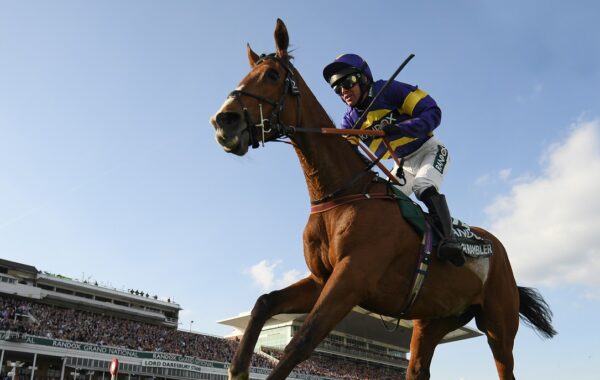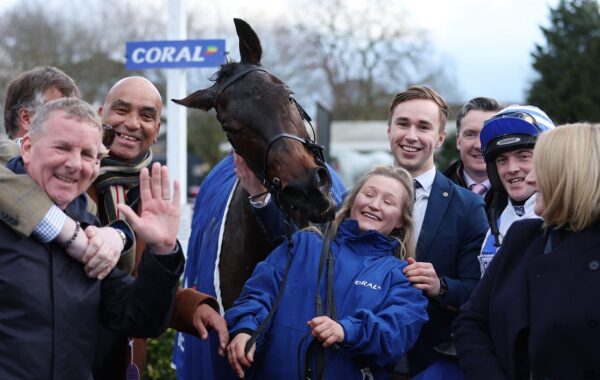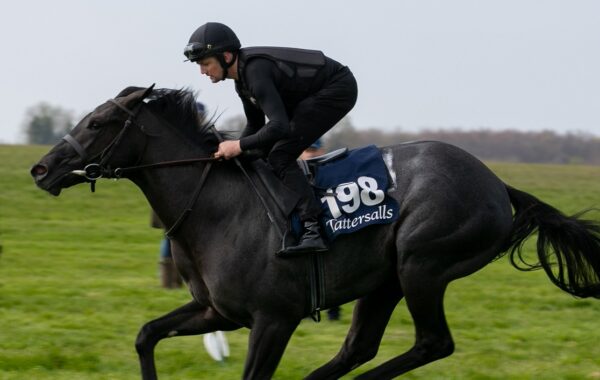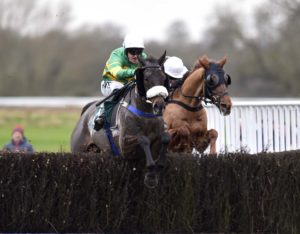One of Flat racing’s understated success stories in recent years has been Andrew Balding’s gradual ascent of the career ladder.
Balding closed last season having set a series of personal bests. His 126 winners in Britain accrued prize-money in excess of £3.6 million, and he closed the campaign by saddling Donjuan Triumphant to land the QIPCO British Champion Sprint Stakes.
That was Balding’s first winner on Champions Day, which celebrates its tenth anniversary this year, and with a fair following wind he will return to Ascot in October with designs on the Queen Elizabeth II Stakes. Kameko will carry the stable pennant on a day sponsored by the family of the colt’s owner, Sheikh Fahad Al Thani.
Donjuan Triumphant’s victory was gained at odds of 33/1 but nothing so extravagant will be available about Kameko. His victory in the 2,000 Guineas back in June was Balding’s second Classic winner after Casual Look’s Oaks triumph in the trainer’s inaugural season in 2003.
This has been a campaign of trial and error for Kameko, when the colt’s extravagant talent has made all things seem possible. But his last run, when a non-staying fourth in the extended ten furlongs of the Juddmonte International, marked him down as a miler.
“What helped was that we started to strike the right balance”
Even without Kameko, Balding’s Park House Stables, in the village of Kingsclere, has enjoyed another fruitful year. “I’ve been fortunate to have a broad balance of horses and we have contested more than our fair share of Pattern races,” he reflects. “We have won a few and several other horses have been placed.
“We also have some good two-year-olds, which is always an exciting way to finish off any season. You always want more, but to be where we are now compared to where we were 12 years ago, we have to be pretty happy.”
A look back to that chapter illustrates the point. In statistical terms 2007 represented something of a nadir, when Park House sent out just 39 winners in Britain. Balding’s signature victory that year was posted by the Queen’s Banknote, who landed the Group 3 Badener Meile in Germany.
“It was about that time when I realised the maths wasn’t adding up,” the trainer relates. “It was a struggle financially. We lost one of our biggest owners the year before I took over from my father [Ian] when Robert Hitchens died. He had more than 30 horses with us, and we’d also lost [Mill Reef’s owner-breeder] Paul Mellon, who was a huge supporter. They were big voids to fill.
“It was also a time when we campaigned abroad with horses like Phoenix Reach,” he continues. “Their earnings didn’t show up in the statistics, but what helped was that we started to strike the right balance.
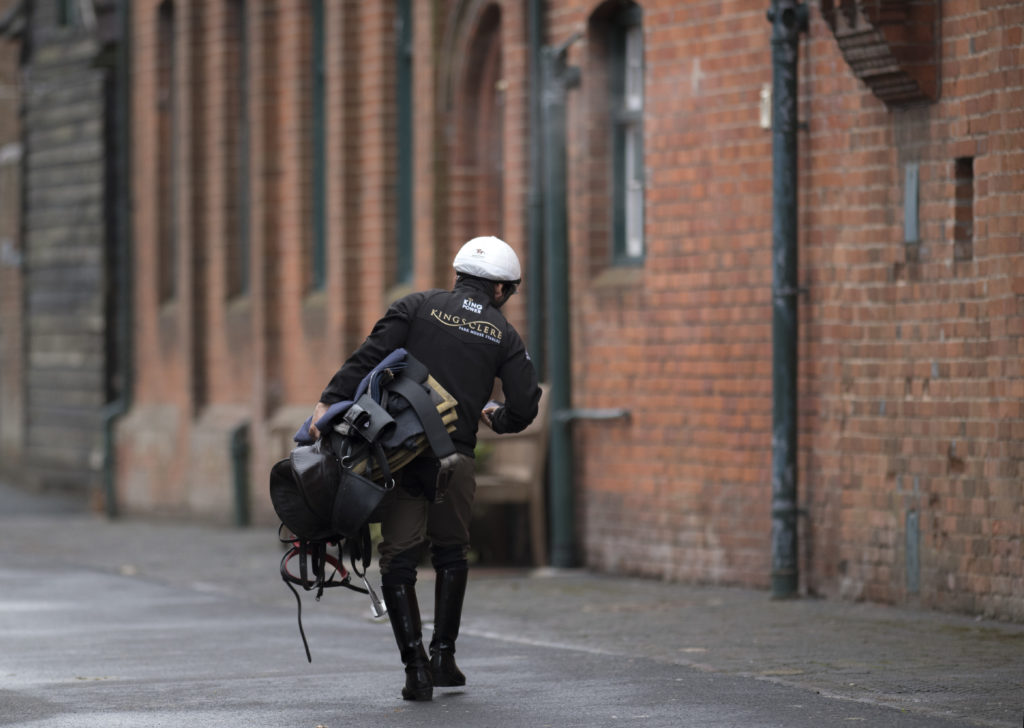
There are 70 full-time employees at Balding’s Kingsclere Stables, with the majority living on site – Photo: George Selwyn
“We managed to retain some decent horses while selling others so that their owners could reinvest. We were generating income, so while our results got knocked back, the reinvestment allowed us to move forward.”
A more visible expression of the subsequent change in fortunes can be seen in the Colour Room at Park House. It has the feel of a museum: a potted history of the historic stables as told through the array of racing silks, many of them instantly recognisable, of Park House’s patrons down the decades.
In the fallow years not too many of those silks would have struck a chord. Yet subsequent additions attest to the recognition Balding has since earned from some of the biggest owners.
In the gallery today hang the colours of Sheikh Fahad and other members of the Qatari royal family. Dubai is represented by Sheikh Juma Dalmook Al Maktoum and Ahmad Al Shaikh, whose Khalifa Sat chased home Serpentine in the Derby.
They are abetted by the blue-and-white robes of King Power Racing from Thailand, together with those of Team Valor, Kirsten Rausing, Fitri Hay and Mick and Janice Mariscotti. It is an eclectic mix to add to the likes of The Queen, Jeff Smith and George Strawbridge, who have been ever-present since Balding started out 17 years ago.
“Throughout these infrastructure changes we have been very conscious of the history of the place”
“To get that sort of roster is something we set out to do from the beginning,” Balding says. “Training for them is like being dealt a pocket pair of aces. It becomes much easier to play the rest of your hand.”
It’s fitting that Park House is back among the foremost training establishments in Britain. Several great horses have graced the estate, which today embraces 1,500 acres.
John Porter trained seven Derby winners there from 1867, among them the triple Crown winners Ormonde (1886), Common (1891) and Flying Fox (1899). A yard at Park House is named after Ormonde, the Frankel of his era who retired unbeaten after 16 starts.
The yard from which Porter trained has been supplemented by others over time. Balding’s father, Ian, trained there for 39 years, during which he saddled more than 2,000 winners, and there have since been further additions as the present incumbent’s string swelled to more than 200 horses.
“We have built new barns, new stabling and new gallops,” Balding says, “but throughout these infrastructure changes we have been very conscious of the history of the place.
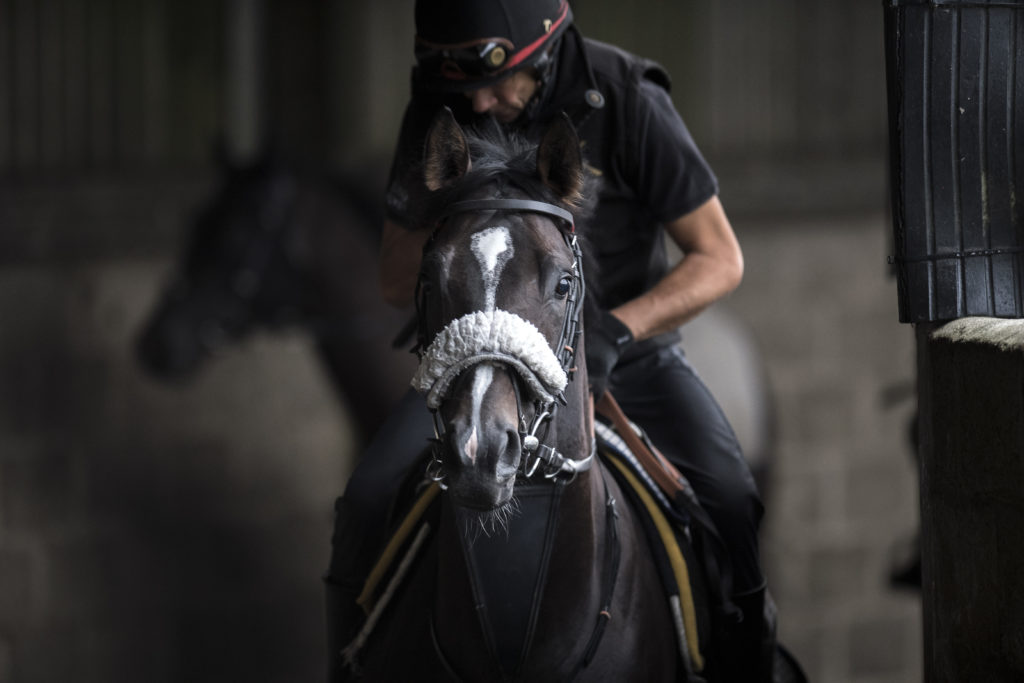
Kameko exercising in the indoor school before first lot – Photo: George Selwyn
“The flip side of having a big string is that it becomes a lot more difficult to manage. We have over 70 full-time employees, the majority of whom live on site. My wife Anna Lisa has done a great job dealing with that, as have all the others in our management team in their own spheres.
“My assistant, Nigel Walker, and my racing manager, Tessa Hetherington, have important roles, while my mother [Emma] still plays a big part. It’s a proper team effort, which allows me to concentrate all my efforts on training horses.”
Every ounce of it has been required in this Covid-affected campaign. The turf season was just days away from its baptism when racing was suspended in March. Initial uncertainties about its resumption were followed by condensed rescheduling of the big races when the action resumed on June 1. With Kameko due to run in the 2,000 Guineas five days later, Balding was in uncharted territory.
“We’d had our first proper work morning during Cheltenham week, just before lockdown,” he says. “We had to keep Kameko going because until the end of April there was still a chance the 2,000 Guineas would be run as scheduled [on May 2].
“Then we had to take a pause, which wasn’t easy. It was the same for every trainer but happily it worked out for us. We managed to get it right, certainly for the Guineas, although a better trainer would probably have worked out Kameko’s best trip before I did!”
“Training for my owners is like being dealt a pocket pair of aces”
As for the lockdown itself, Balding almost shudders at the memory. “Even with 200 horses around me, I felt like I was on a sabbatical,” he recalls.
“I felt redundant from 12.30pm, when we finish with the morning, until evening stables. There was no need to go racing, no racing to watch on television and no owners coming to the yard.
“At the time I was more worried about what was happening around the country, rather than in our little world in racing. But it was deeply concerning not knowing when racing would resume.
“If the shutdown had lasted into July we would probably have had to lay off some of our staff. Happily, that situation didn’t arise, and we didn’t lose a single horse through it, which was amazing. I always knew I was blessed to have a wonderful bunch of owners and that just confirmed it.”
Since resumption the pace of the truncated season has been unrelenting. “We haven’t been able to pause for breath,” he says. “It’s been one seven-day week rolling into another. It’s extraordinary: winning the Guineas seems like something that happened two years ago.”
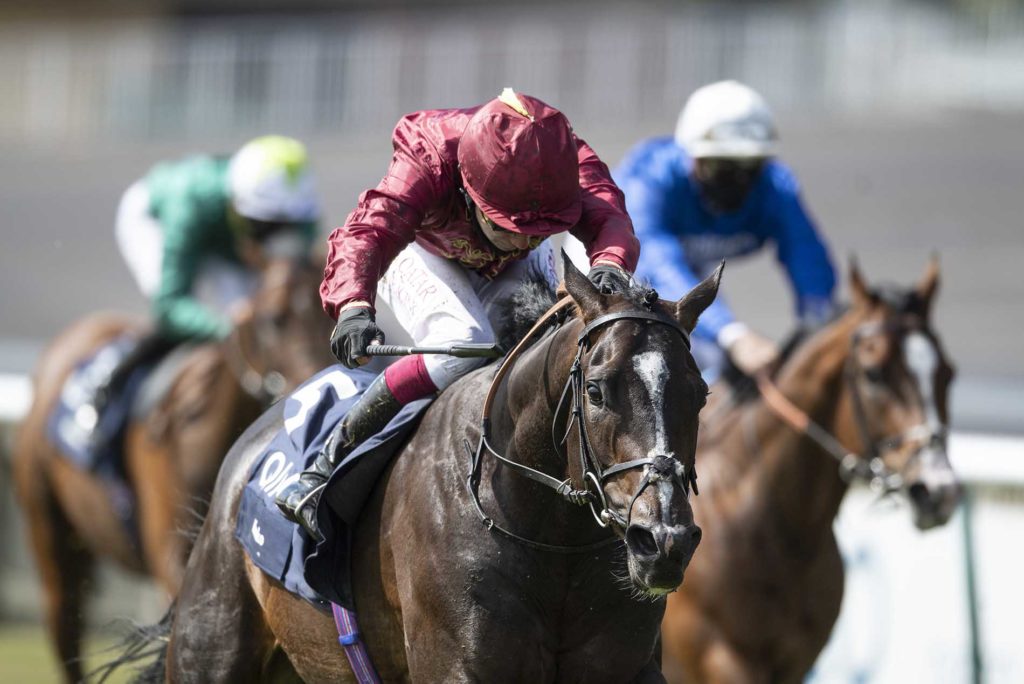
Kameko en route to winning the 2000 Guineas. Pic: Edward Whitaker
Despite that Classic triumph, the pandemic’s negative effect on prize- money leaves Balding with no prospect of matching last year’s haul. He accepts the reasons behind it without protest, although pre-Covid prize-money levels were already causing him lament.
Balding has raced horses in just about every global jurisdiction. Having won Group 1 races in Canada, Dubai and Hong Kong, he is well placed to offer an assessment of racing in Britain and how it compares internationally.
He proffered his thoughts without prompting, and with a mixture of melancholy and incredulity. The words tumbled out of him in torrents, the sound of them serving only to heighten his angst at what he perceives as a grave injustice.
“The constant in-fighting means we never properly celebrate what we actually have in British racing,” he starts. “The rest of the world looks up to what we have, and as far as I can see, it is only prize-money that’s lacking.
“Look at the overall picture,” he continues. “We’ve got great racecourses, we’ve got great horses, we’ve got owners from different backgrounds, staff from different backgrounds, and we’re producing top-class jockeys.
“We’ve got so much that every other racing nation is hugely envious of. We’re so close to having everything but it just needs a little bit of imagination to try to get us over the line in terms of getting that extra prize-money.”
So what’s the solution? “I think it can be done if we all work together to generate more income for the bookmakers – provided they are fair with us in return. It’s about raising the sport’s profile, which, through the Covid situation, is happening right now. Television viewing figures are up, and I’ve been amazed by friends who are not into racing who have been watching it. They have become really engaged.
“The constant in-fighting means we never properly celebrate what we actually have in British racing”
“This has to be the way forward. It’s daft to clutter up newspapers with meaningless racecards; we need to focus on the top end of the sport. I totally understand the bottom end needs help and support but it is in everybody’s interest, whether they train 20 horses or 200, because it all filters down from the top.
“If we can generate interest and enthusiasm among the public, betting revenues go up. That is a challenge we can all face together. Our racing festivals are so fantastic, we’ve got to push everyone in that direction. A little imagination can take us a long way.”
He also believes more should be made of the annual race to be champion jockey, with a Grand Prix-style format in which points are awarded for the better races.
“It’s pointless for jockeys to be charging around the country every day,” he says. “They will burn out, and as things stand, the one who becomes champion is the one with the fastest aeroplane or the hungriest agent. That’s not right.”
Ironically, the current champion, Oisin Murphy, is a product of Balding’s renowned apprentices’ academy at Park House. He is also Kameko’s regular rider on account of his retainer with Sheikh Fahad.
In the short term Murphy is young enough to cope with the workload, although Balding will want him fresh as paint when next season starts. Balding has never previously retained a Classic winner to race at four and although there has been no final decision on whether or not Kameko stays in training, he is palpably enthused by the prospect.
“I’m excited by the thought of it,” he says. “The horse has had a busy time in the last 16 months so I’d like him to have a winter’s break. He is without a doubt the best I have trained. I don’t think he’s had much luck this year and with a clearer run I hope he will show just how good he really is.”
With Kameko in harness and those two-year-olds waiting in the wings, Balding has much to anticipate. His ascent of the career ladder looks set to continue unabated.



